The Monoxenous Life Cycle Of Eimeria: Difference between revisions
No edit summary |
No edit summary |
||
| Line 9: | Line 9: | ||
==Life Cycle== | ==Life Cycle== | ||
[[Image:Eimeria_Life_Cycle.jpeg|thumb|300px|right|<b>Figure 2.</b> Illustration of the life cycle of <i>Eimeria</i>. Image from the USDA website. https://www.ars.usda.gov/northeast-area/beltsville-md/beltsville-agricultural-research-center/animal-parasitic-diseases-laboratory/docs/coccidiosis/]] | [[Image:Eimeria_Life_Cycle.jpeg|thumb|300px|right|<b>Figure 2.</b> Illustration of the life cycle of <i>Eimeria</i>. Image from the USDA website. https://www.ars.usda.gov/northeast-area/beltsville-md/beltsville-agricultural-research-center/animal-parasitic-diseases-laboratory/docs/coccidiosis/]] | ||
==Phase Morphology== | ==Phase Morphology== | ||
==Metabolism== | ==Metabolism== | ||
| Line 21: | Line 18: | ||
[[Image:Mannitol_enzymes.png|thumb|300px|right|<b>Figure 4.</b> The enzymes that function in the mannitol cycle appear to be the most active around the temperature level of the body of the host organisms. <ref>[http://www.sciencedirect.com/science/article/pii/0166685189900753 Schmatz, D.M., Baginsky, W.F., and Turner, M.J. “Evidence for and characterization of a mannitol cycle in Eimeria tenella.” Molecular and Biochemical Parasitology 32.2-3 (1989): 263-270.]</ref>]] | [[Image:Mannitol_enzymes.png|thumb|300px|right|<b>Figure 4.</b> The enzymes that function in the mannitol cycle appear to be the most active around the temperature level of the body of the host organisms. <ref>[http://www.sciencedirect.com/science/article/pii/0166685189900753 Schmatz, D.M., Baginsky, W.F., and Turner, M.J. “Evidence for and characterization of a mannitol cycle in Eimeria tenella.” Molecular and Biochemical Parasitology 32.2-3 (1989): 263-270.]</ref>]] | ||
==Infection and Diagnosis== | ==Infection and Diagnosis== | ||
==Effects on the Body== | ==Effects on the Body== | ||
| Line 31: | Line 28: | ||
==Treatment and Prevention== | ==Treatment and Prevention== | ||
==Impact on Poultry Market== | ==Impact on Poultry Market== | ||
==Immunization== | ==Immunization== | ||
| Line 38: | Line 37: | ||
==Conclusion== | ==Conclusion== | ||
==References== | ==References== | ||
<references /> | <references /> | ||
<br><br>Authored for BIOL 238 Microbiology, taught by [mailto:slonczewski@kenyon.edu Joan Slonczewski], 2017, [http://www.kenyon.edu/index.xml Kenyon College]. | <br><br>Authored for BIOL 238 Microbiology, taught by [mailto:slonczewski@kenyon.edu Joan Slonczewski], 2017, [http://www.kenyon.edu/index.xml Kenyon College]. | ||
Revision as of 18:54, 24 April 2017
Introduction
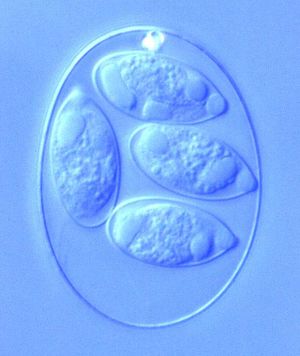
By Emma Stewart-Bates
Eimeria is a genus of protozoa that are parasitic to many vertebrate animals, most often cattle, domesticated birds, goats, and sheep. These parasites contain an apical complexes and apicoplasts, organelles that allow the cell to enter a host organism. The life cycle of Eimeria is considered monoxenous, meaning that the cycle occurs in one host. The three stages of its life cycle include oocyst, sporozoite, and merozoite. They undergo both sexual and asexual reproduction during different stages of their life. Animals infected by Eimeria often develop the disease coccidiosis, which mainly causes diarrhea, fatigue, and loss of appetite. Coccidiosis is spread when an animal ingests infected tissue or is exposed to contaminated feces.[1]
Life Cycle
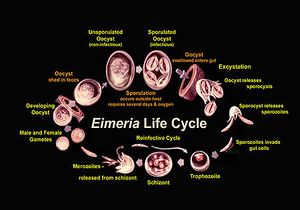
Phase Morphology
Metabolism
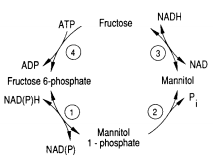
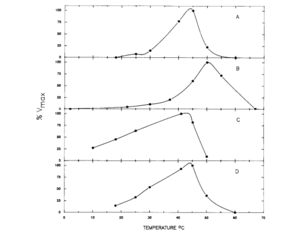
Infection and Diagnosis
Effects on the Body
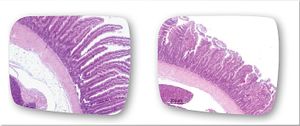
Treatment and Prevention
Impact on Poultry Market
Immunization
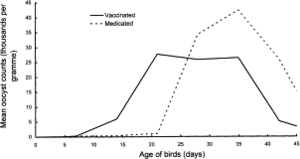
Conclusion
References
- ↑ "Eimeria." The Australian Society for Parasitology Inc., 16 June 2010. Web. 15 Apr. 2017.
- ↑ Schmatz, D.M., Baginsky, W.F., and Turner, M.J. “Evidence for and characterization of a mannitol cycle in Eimeria tenella.” Molecular and Biochemical Parasitology 32.2-3 (1989): 263-270.
- ↑ Schmatz, D.M., Baginsky, W.F., and Turner, M.J. “Evidence for and characterization of a mannitol cycle in Eimeria tenella.” Molecular and Biochemical Parasitology 32.2-3 (1989): 263-270.
- ↑ https://eimeriaprevention.com/news/coccidiosis-in-chickens-and-subclinical-species-of-eimeria/ “Coccidiosis in chickens: the role of subclinical species of Eimeria.” Eimeria Prevention. HIPRA, 16 Sept. 2016. Web. 19 Apr. 2017.]
- ↑ http://www.sciencedirect.com/science/article/pii/S0020751998002124 Williams, R.B., W.W.H. Carlyle, D.R. Bond, and I.A.G. Brown. “The efficacy and economic benefits of ParacoxⓇ, a live attenuated anticoccidial vaccine, in commercial trials with standard broiler chickens in the United Kingdom.” International Journal for Parasitology 29(1999): 341-355. Web..]
Authored for BIOL 238 Microbiology, taught by Joan Slonczewski, 2017, Kenyon College.
